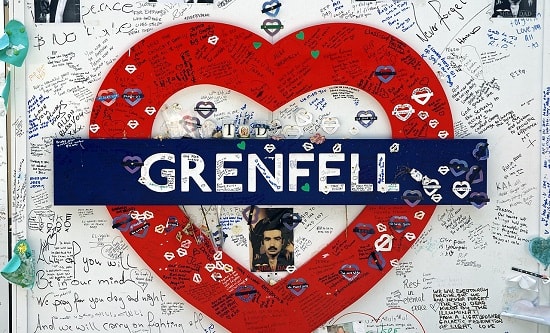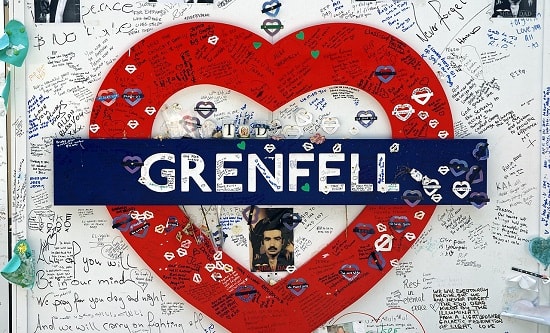
The despicable saga of the 2012-2016 ‘refurbishment’ of Grenfell Tower in west London was driven by cost-cutting on the part of Kensington and Chelsea council, and profiteering on the part of every last contractor and manufacturer involved. The victims were, inevitably, the working class residents of the north Kensington tower, 72 of whom were killed by the raging fire that broke out on 14 June 2017. This disaster was the direct result of a deregulated and profoundly corrupt building sector in which criminality flourished. While companies like Arconic, Celotex and Kingspan knowingly gamed the system,[1] they were aiming at an open goal, with British building regulations amongst the most lax in Europe. As we wrote at the time: ‘the fire at Grenfell Tower exposes the scale of corruption that permeates authority in Britain. It is driven by corporations scrambling for profits, bending rules and regulations, and breaking them to do so. In these calculations, human beings… are disposable.’[2]
A ‘bonfire of red tape’
The Building Regulations Act of 1984 sets out broad standards for the industry, but is pretty laissez-faire about how they are achieved. In 1985, under Margaret Thatcher, 306 pages of building guidelines were stripped down to just 24. Until 1985 it was compulsory to use cladding that was flame resistant for 60 minutes. Afterwards it was discretionary. In 2010, considering reports on the 2009 fire at Lakanal House in south London in which six people died, the Department for Communities and Local Government (DCLG) sought views from the fire safety sector in which it emphasised that any recommendations on fire safety compliance should focus on what savings could be made. In 2012 former Communities and Local Government Secretary Eric Pickles went further, repealing Sections 20 and 21 of the 1984 Act, so that the exterior of buildings no longer had to be fireproof. This was done in the name of the then business secretary Sajid Javid’s, ‘red tape challenge’, intended to get rid of £10bn worth of ‘unnecessary’ regulations. The new guidance – ‘Approved document B’ – set out two standards for external wall coverings. Insulation must be of ‘limited combustibility’ – ie able to withstand 750C for two hours. But cladding is only required to meet a Class O standard, where heat is applied to a rectangular sample of surface material only for ten minutes.
Phase 1 of the Grenfell Inquiry established that the polyethylene (PE) core of the aluminium-composite material (ACM) cladding caused the rapid spread and ferocity of the fire. Expert witnesses have testified that PE ‘burned like petrol’ when ignited. Yet the use of Reynobond 55 PE (supplied by the French division of the US materials giant, Arconic) on a tower block was perfectly legal, given its Class 0 fire safety rating.
In reality, the product used at Grenfell had failed the fire safety test, an inconvenient fact that, as the inquiry has revealed, Arconic went to great lengths to cover up.
Evidence presented at the Grenfell Inquiry in February shows Arconic knowingly marketed a product it knew was lethal. Its PE panels were available in two forms – riveted flat to a building or hung in ‘cassette’ form. While in 2007 tests the riveted panel achieved a B rating (roughly equivalent to a British O, and therefore able to be used on residential buildings) the cassettes failed spectacularly, and were rated ‘E’ – something a Spanish client later described as one step up from spontaneous combustion. But Arconic marketed Reynobond PE as Class B. An email from one of its executives, Claude Wehrle, states: ‘for the moment, even if we know that PE material in a cassette has a bad behaviour exposed to fire, we can still work with national regulations which are not so restrictive’ – ie Britain.
Arconic, as well as insulation providers Kingspan and Celotex, were able to acquire the certification they needed to plaster their highly combustible products all over residential buildings in Britain with comparative ease. In 1997, under a Labour government, the main agencies that set and enforce safety standards – the Building Research Establishment (BRE), British Standards Institute (BSI) and British Board of Agrément (BBA) were privatised and required to be financially self-supporting. They rely for part of their income on testing and certifying commercial products.
So in 2013, when Arconic needed to renew its Reynobond PE certification, it approached the leading industry body, the BBA. The BBA demanded test data: Arconic threatened to withdraw all its custom unless a ‘satisfactory solution’ were found. Eventually – based on partial data and Arconic’s own website blurb – the BBA certified the Reynobond PE cladding as having ‘a Class O surface’ – paving the way for its use on Grenfell. BBA has since conceded the certificate was ‘misleading’.
The fire-testing service, BRE, appears to have been similarly pliable. Insulation, even under Britain’s loose regulations, is required to meet a high standard of ‘limited combustibility’ on buildings over 18 metres. In 2007, Kingspan’s Kooltherm 15 insulation produced a ‘raging inferno’ in tests. So it used a 2005 pass – on a different product – to acquire in 2009 a local authority certificate. Based entirely on Kingspan’s own evidence, a Hertfordshire council official agreed the highly flammable plastic foam product was in fact ‘of limited combustibility’. ‘Fanbloodytastic!’ marketing manager Phil Heath emailed a colleague at the time, ‘We didn’t even need to pour much real ale down him.’ In 2014, Kingspan failed a BRE test but managed to get the engineer, Phil Clark, not to specify that crucial fact in his report. Kingspan submitted the false report to 29 ‘desktop studies’ to show its product was suitable for use on high rise buildings. Clark would later go on to work for Kingspan. BRE appears to have had an equally cosy relationship with Celotex. In March 2014, Celotex failed a BRE fire test. After an unauthorised chat with the test engineer, the company took another, rigged, test in May and passed. Celotex’s former assistant product manager Jonathan Roper admitted that the company had been ‘dishonest’ but was keen to emulate Kingspan’s approach ‘to avoid limiting sales’.
Cheap and deadly
A number of countries have prohibited the use of ACM cladding for years. By 2013, a series of major fires worldwide associated with it forced Arconic, reluctantly, to inform its offices in Europe that it was reclassifying Reynobond 55 PE at the lowest safety grading of E. Henceforth, sales reps should only promote the fire-retardant (FR) version. But UK sales manager Debbie French nonetheless sold the extremely combustible cassette cladding to the Grenfell refurbishment team. She told the inquiry the UK was ‘a PE market’, which generally preferred a slightly cheaper product, albeit with a greater fire risk. Arconic senior executive Gwenaëlle Derrendinger agreed: because Grenfell was ‘a UK project’, unless anyone specifically requested FR materials, they got the cheaper PE version. Using PE rather than FR saved Kensington and Chelsea Council around £30,000 – 0.3% of the refurbishment budget. For Arconic, there is a slightly higher profit margin on PE than FR, and by 2017, it had sold 650,000 sq metres of its PE cladding in Britain: the deadly material is still in place on hundreds of residential blocks and towers across the country.
203 tall residential buildings across England still have unsafe ACM cladding, despite the government’s target for remedying the situation by June 2020. Hundreds of thousands of leaseholders living in unsellable and potentially dangerous high-rise homes could now face crippling fire safety bills of up to £100,000 each after MPs voted in March against a proposal to protect them from the costs.
While the government has promised £5bn to replace combustible cladding, this does not cover other fire safety defects and only applies to buildings over 18 metres in height. That has left leaseholders on shorter blocks with dangerous cladding and people with defective fire doors or missing fire breaks in wall systems with unsellable homes and huge bills. Meanwhile, freeholders, developers and the manufacturers of lethal cladding products are laughing all the way to the bank.
Even after the Grenfell fire, Kingspan continued to lobby the then housing secretary Sajid Javid not to ban the use of combustible materials on high rise buildings. London Fire Brigade has implemented only four out of 29 recommendations made by the inquiry over a year ago – in particular it has not changed its ‘stay put’ advice.
In a capitalist state where, as Milton Friedman put it, ‘the only social responsibility of business is to increase its profits’, the callous disregard for human life and sheer criminality is not a surprise. This is the system we have to fight if we want justice for Grenfell and housing safety for us all.
Cat Wiener
[1] https://www.insidehousing.co.uk/insight/insight/grenfell-tower-inquiry-diary
[2] FRFI 259, August/September 2017, ‘Condemn capitalism’.




